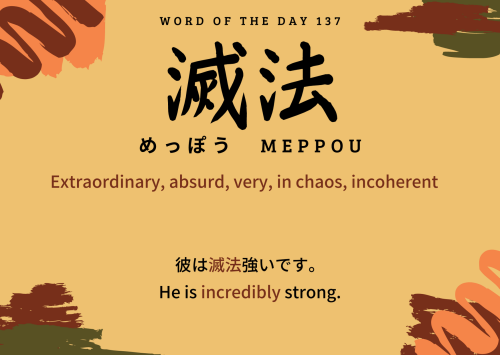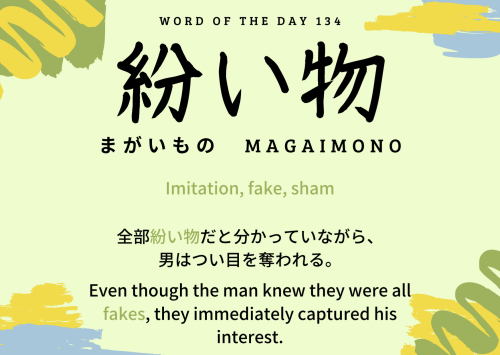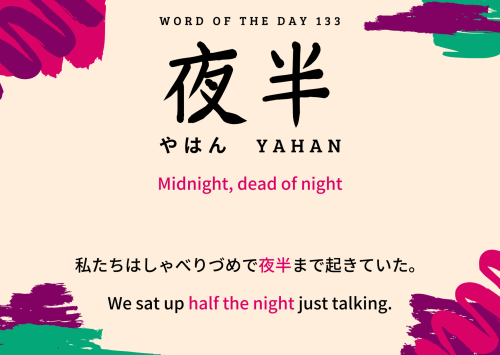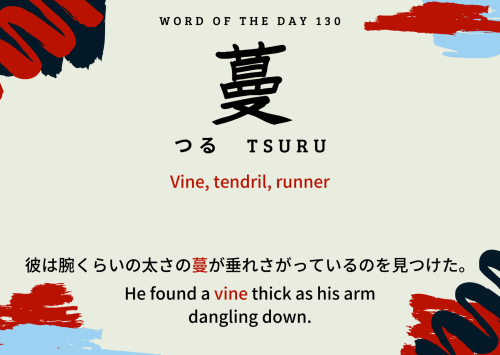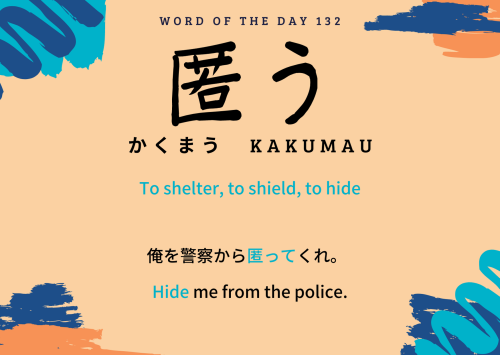#japanese vocabulary

Here’s a new word I encountered in the course the other day, and that I have also seen in a Ghibli movie!
地下鉄(chikatetsu) : subway, underground train:
- 地 means “ground”;
- 下 means “under”;
- 鉄 means “iron”.
Sentence Example
This word can be used with the verb 乗る(noru), “to ride”. Here’s an example with the formal version of 乗る, 乗ります(norimasu):
地下鉄に乗ります。(chikatetsu ni norimasu) -> I will take the subway
Analysis:
地下鉄 に 乗ります。
(chikatetsu) (ni) (norimasu)
the subway in I ride/will ride = In the subway I will ride= I will take the subway.
The verb 乗る/ 乗ります (to ride) being present, you add に after the means of trasportation you will ride in.
Background pic by Leon WarnkingfromPexels
P.S.: I am just a student of Japanese, if you are more experienced with the language and want to point out an error, feel free to let me know, and I will correct the error as soon as possible!
Japanese with Studio Ghibli - From Up on Poppy Hill

From Up on Poppy Hill is one of the first Studio Ghibli movies I have ever seen, probably the second after The Secret World of Arrietty. It is a quiet, peaceful story of everyday’s life and romance, set in the beautiful scenery of Yokohama.

The movie’s title in Japanese is コクリコ坂から(Kokuriko-zaka kara, From the Hill of Poppies):
- コクリコ(Kokuriko) means “poppies”. You may have noticed that it is written in katakana: that’s because it is a loanword, from the French word for poppy, Coquelicot. I don’t know if there’s a Japanese word for this flower, nor if the flower was already known in Japan before it came from Europe…
- 坂(zaka)means “Hill”. Interesting enough, the name “Poppy Hill” seems to come from the name of the boarding house where the main character Umi and her family live, Coquelicot Manor. I initially thought “Poppy Hill” was the name of a neighborhood in Yokohama :)
- から means “from” when put at the end of a noun. This word is mantained in the English title From Up on Poppy Hill, while it is omitted in the Italian title (yep, Italian is my first language) La Collina dei Papaveri, “The Hill of Poppies”. Anyway, I like all of them :)
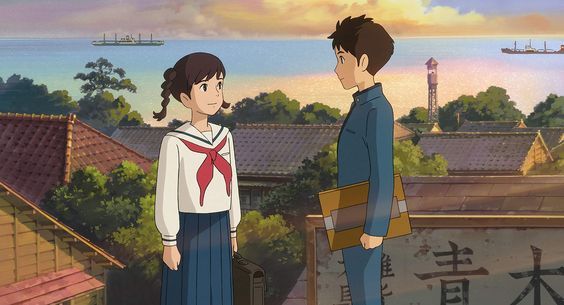
As I said, this movie shows glimpses of everyday’s life in Japan, therefore it is well suited to learn some common expressions, like the following:
- ただいま!(Tadaima!) : “I’m home”
- お帰りなさい / お帰り (Okaerinasai / okaeri) : “Welcome back (home)”. From what I’ve seen 帰る(kaeru) means something like “return, go back, go home”.
- 行ってきます(Ittekimasu): “I’m off, I’m leaving” (行is the kanji for “go”)
- いただきます(itadakimasu): polite expression you use before starting a meal. It’s very difficult to translate (but many attempt to do it on the web, if you want to know more about this word)

This movie is also a good way to learn/review some vocabulary about the family, since families, and the relationship between parents and their children is a main theme of the story. Those are some of the words about family I recognized:
- お母さん(okaasan): “mother, mum”
- お父さん(otousan): “father, dad”
- 子(ko): “child” can be either son or daughter
- 息子(musuko): “son”
- おねえちゃん(oneechan): “big sister”.
- 兄弟(kyoudai): “siblings, brothers”

Those are just a few examples, the words that I noticed either because often repeated throughout the movie or because I already heard them in my Japanese course. Anyway, if you have the chance to watch this movie, take it, and enjoy this sweet story while learning (or reviewing) Japanese vocabulary!
P.S.: I am learning Japanese as an amateur, by exploring this language and its culture and making new discoveries every day. This means that I am not fluent in Japanese, and that I can make a lot of errors! If you are a native speaker or a student already fluent in the language, feel free to point at errors in the post, and I will correct them as soon as possible!
Pictures:FROM UP ON POPPY HILL (2011), by Goro Miyazaki, STUDIO GHIBLI.
JLPT Level: Unlisted
Omg I just noticed that the example sentence has こんこん in hiragana beside the kanji. When you copy and paste a sentence that has furigana above the kanji, it will put it as hiragana beside the kanji, and I forgot to go and delete that. /sigh. The correct example sentence is:
ゆき子が昏々と眠った。
Okedoke. Now that that’s out of the way, let’s get on to this word and its kanji.
昏
- On-yomi: kon
- Kun-yomi: kura.i, kure
- Meaning: dark, evening, dusk
This kanji is made of two different parts: 氏 and 日. 氏 represents a person and 日 is the sun. The person is standing above the sun, and therefore this kanji is a pictograph of “the sun falling to a person’s footsteps,” which is a rather pretty way to describe the sun setting. And of course, after the sun sets, it becomes dark, which explains why this kanji means “dark.”
Now, why does the word “konkon” mean fast asleep? Well, most people tend to sleep at night haha. Of note, this kanji appears in the word for “coma,” which is 昏睡 konsui. So this kanji has nuances of a very deep sleep.
Post link
JLPT Level: Unlisted, but the kanji are N1 and N3 respectively.
Alright, this is a pretty interesting word that’s seen some changes in meaning and usage over the centuries.
滅
- On-yomi: metsu
- Kun-yomi: horo.biru, horo.bu, horo,bosu
- Meaning: destroy, ruin, overthrow, perish
法
- On-yomi: hou, ha, ho, furan
- Kun-yomi: nori
- Meaning: method, law, rule, principle, model, system
If we put the two together, we get “The Law of Destruction,” which could be a pretty rad metal song.
Originally, this was a Buddhist term used to refer to…something too hard for me to wrap my pea brain around haha. Really trying to remember everything I learned in that one Buddhist Philosophy course I took in uni back in the day.
Okay okay. Basically, all things in existence are divided into two categories:
- Conditioned existence (a.k.a. things created by fate). This is known as saṃskṛta in Sanskrit.
- Those that have transcended conditioned existence. This is known as asaṃskṛta in Sanskrit.
Meppou is the old Japanese Buddhist term for “things that have transcended conditioned existence.” This can mean that a thing has reached Nirvana, something that is “absolute.”
From that meaning, meppou came to mean something “extraordinary” or “terrible and intense” like a historic typhoon.
Most of the time, meppou is used in the phrase 滅法強い meppou tsuyoi, “terribly powerful.”
Post link
JLPT Level: N1, and the kanji are N1 and unlisted respectively.
Most of the time, this word is written in hiragana. But the kanji are funny, so I’m gonna talk about those too.
矢
- On-yomi: ya
- Kun-yomi: shi
- Meaning: dart, arrow
鱈
- On-yomi: setsu
- Kun-yomi: tara
- Meaning: codfish
So…put these two together and you get… “shooting codfish with arrows” and somehow that is supposed to mean “indiscriminately; blindly; at random; recklessly; thoughtlessly; excessively; profusely.”
I bet you’re ready for me to blow your mind with some anecdote from like 700 years ago about some old Japanese hermit who only had an arrow and spent everyday in the same stream trying to catch cod unsuccessfully, because he was an idiot and didn’t know that cod were an ocean fish and not a freshwater fish.
…But actually, these are just ateji. Ateji are kanji whose meaning have nothing to do with the word they are used in. Their pronunciation just conveniently matches the word. So “arrow” and “codfish” have absolutely nothing to do with yatara and its meaning.
Kanji, man. Can’t trust ‘em. :P
Post link
JLPT Level: Unlisted
This is one of the coolest words I have found to date. Look at those meanings!! To boast, to roar, to recite a poem to oneself. It’s so rich and nuanced! And then look at how dang cool the kanji looks!! Also, let’s not forget that the pronunciation, “usobuku” sounds like 嘘吹く (uso fuku, to tell lies like the wind blows), which is not a real expression but is immediately what my mind goes to.
Okay, let’s take a look at this kanji!
嘯
- On-yomi: shou, shitsu
- Kun-yomi: usobu.ku
- Meaning: roar, howl, recite emotionally, feign indifference
It appears that long ago, this kanji used to be used for whistling. But not just any whistling–this is for the whistling people did to imitate bird calls.
Nowadays, this word is very seldom used, and it is never used in reference to bird calls. But it’s really cool!
Post link
JLPT Level: Unlisted, but the kanji are N1 and N4 respectively.
Okay, this one is so low frequency you’ll probably never see it. But I like how it sounds so I’m gonna talk about it haha.
紛
- On-yomi: fun
- Kun-yomi: magi.reru, -magi.re, magi.rasu, magi.rawasu, magi.rawashii
- Meaning: distract, be mistaken for, go astray, divert
物
- On-yomi: butsu, motsu
- Kun-yomi: mono
- Meaning: thing, object, matter
So if we put these two together we get “something that one mistakes for something else.” Pretty easy to understand, I think. I wanted to talk about the etymology of the kanji 紛 but I couldn’t find anything. T-T
Post link
JLPT Level: Unlisted, but the kanji are N4 and N5 respectively.
This is a pretty low-frequency word. It sounds pretty old-timey, and it makes sense because I found it in a manga that takes place in the Edo Period haha.
Let’s take a look at the kanji:
夜
- On-yomi: ya
- Kun-yomi: yo, yoru
- Meaning: night, evening
半
- On-yomi: han
- Kun-yomi: naka.ba
- Meaning: half, middle, odd number, semi-, part-
Put them together and you get “the middle of the night.” Pretty easy, right?
Post link
JLPT Level: Unlisted
蔓
- On-yomi: man, ban
- Kun-yomi: habiko.ru, tsuru
- Meaning: vine, tendril, influence, connections, good offices, spread, sprawl, thrive, rampant, powerful
You’re very unlikely to see this kanji in a book, as they’d probably write it in katakana. However, this is sometimes used in last names.
You may recognize the ⺾ radical at the top. This is the “grass” radical and represents “plants.” The other three radicals, 曼, when put together like this, mean “long.”

Here we see the very original kanji for tsuru. At the top we have grass planted in a row. Beneath those we have a hat, followed by a hand, an eye, and another hand at the bottom. I’m not sure why there’s a “hat” here, but there is a hand above and below the eye to signify someone holding out their hands to gesture how tall or “long” something is.
So, something “long” 曼 plus “grass” ⺾ = vines. pretty easy!
Also, as a sidenote, most kanji with 曼 have an on-yomi of “man.”
Post link
JLPT Level: Unlisted, but the kanji is N1
This has an etymology different from what I had expected. Let’s look at the parts!
⼖ to conceal, hide
若 soft mulberry leaves
Now, anyone who has been studying their kanji is probably looking at that definition of 若 and going, “Omoi-no-hoka, you’ve lost the plot” because 若 means young.
And see, I knew that it meant “young” too, so I thought maybe this was a reference to something like “protect the women andchildren.”
But nope! This, my friends, is all in reference to silkworms.
Silk was an incredibly important textile in Japan. The silkworms live in mulberry trees, eating the young, soft leaves. 匿 represents the mulberry leaves that fill up the silkworms’ bellies and stay hidden there.
Kinda weird, but there ya go!
Post link
JLPT Level: Unlisted, but the kanji are N4 and N3 respectively.
While not a super common word, you do have a chance of hearing it in conversation once in a blue moon. It’s also incredibly easy to understand once you know the parts.
言い ii, to say
伝え tsutae, to communicate, transmit
So 言い伝え is something that is spoken and transferred from one generation to the next.
Post link
JLPT Level: N1
Three JLPT words in a row? What is happening?
Okay. I knew going in that this kanji wasn’t going to have a very cheerful etymology because of its meaning, but it’s way, way darker than I had imagined. Brace yourselves for some pretty morbid stuff.
嘆 is made of two parts: 口 (mouth) and 漢 without the ⺡. Generally, 漢 represents “China.” But not in this kanji. Ohhhhh no. Strap yourselves in.
In ancient Japan, many different sacrifices were made to different gods, and when there were famines due to drought, miko (Shinto shrine priestesses) were burned alive as human sacrifices.
The 漢 part of this kanji represents 旱魃 Kanbatsu, which can mean either “drought” or “the God of Drought.”
So if you put mouth 口 and the God of Drought 漢 without the ⺡together, you get, “a cry to the God of Drought.”
Nowadays, I would say that almost no Japanese people know about the dark rituals this kanji alludes to. This word is used most often for grieving or mourning, though, so there is still a connection to death.
Post link
JLPT Level: N1, and the kanji are N3 and N2 respectively.
Wow, two words that are on the JLPT in a row. Am I losing my edge?
Let’s break down the kanji:
到
On-yomi: tou
Kun-yomi: ita.ru
Meaning: arrival, proceed, reach, attain, result in
底
On-yomi: tei
Kun-yomi: soko
Meaning:bottom, sole, depth, bottom price, base, kind, sort
So we can put these two kanji together to get the literal meaning of “reaching the bottom.” How does that come to mean “cannot possibly,” or “no matter how”?
Well, I did some expert googling but was unable to find anything. :(
My personal opinion, though, is that it’s either of two things:
- “I am certain to the bottom of my heart that this is impossible.”
- Even if you reach down within yourself and do your best, it is impossible.”
Those are just guesses, and I’m not a native speaker, but that’s my take.
Post link
JLPT Level: N1
Aha!! At long last, a word that is on the JLPT haha.
I could only find one source that explained this kanji. Let’s see what it has to say.
Nowadays, this kanji is a combination of 月 (moon) and 危 (danger). However, the 月 radical can also refer to meat or flesh, and that is meaning it has in this kanji. 危 does mean danger, but actually, the original version of this kanji had 色 (color) there.
Buuuuut, the 色 didn’t actually mean “color” in this kanji. It was a pictograph of someone embracing another from behind.

…I can’t really see it, but I’ll believe you, book.
The book goes on to explain that this original version of moroi with 月 and 色 represented the sensation of touching another person. 脆 represented “softness, beauty, something with a pleasant texture.”
So it appears as though the kanji has a pretty different meaning from the adjective it’s used for, moroi, which means “fragile, brittle, or tender-hearted.”
But if you give it a really hard think, they are certainly connected. A central pillar of Japanese culture is appreciating the beauty of life, because all life is impermanent. So the beauty of a person, in particular, would be a fragile thing, especially back in the day when people had much shorter life spans. That likely gave birth to the “fragile, brittle” meaning.
And once the “fragile, brittle” meaning came to be, that metaphor was extended to people who “break down” into tears easily.
That was a rather winding explanation. Hope it made sense!
Post link
Anyone else doing reviews on wanikani?

It’s my birthday today ^^ I’m turning 30! And what better to do when celebrating one more year on this planet than to do something new that I haven’t done before?
So I want to share with you all my very first series of characters that I’ve made and designed.
怪獣を作りました。They’re monsters, they’re out to scare you and they’re not messing around. Are you ready to meet the first one?
.
.
.
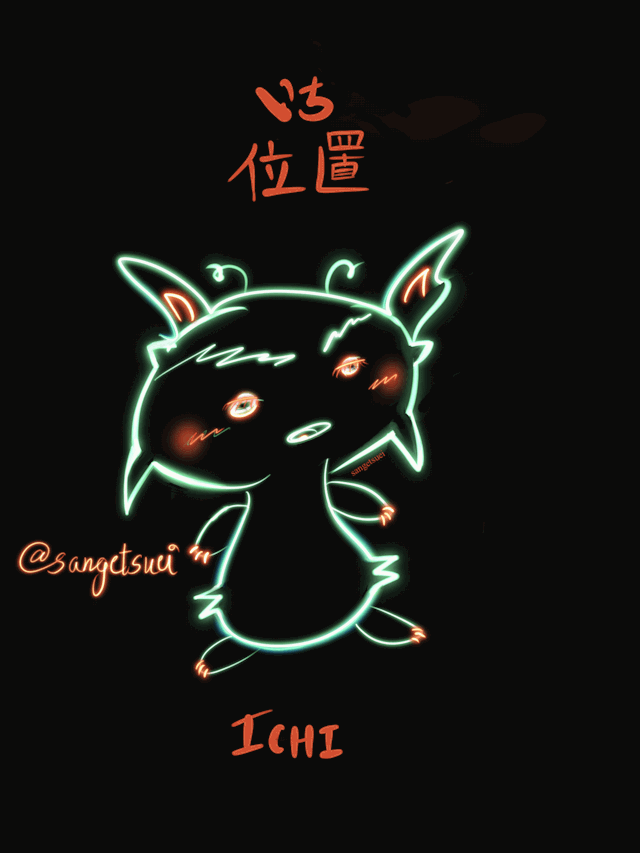
This is Ichi!
Ichi specializes in growls and ferocious glares. However, he also gets embarrassed easily. He can often be found to be blushing and trying to hide in a corner. He likes the smell of coffee but will only drink it if it’s extra sweet. Do tell him he did a good job of scaring you!
The kanji for Ichi’s name 位置 means ‘location’. He picked it himself!
In the following weeks, I will also be introducing Ni, San, Yon, Go, Roku, and Nana. All of them will be available to my patrons on patreon and you may find them interacting with each other and discussing things.
For my birthday, anyone who signs up to be my patron from now until 23:59 hrs of November 05, EST will get a free commission of the kanji of their choice.
If you decide to sign up, check out my set of 2 downloadable 怪獣 (kaijū), meaning ‘monster,’ mobile wallpapers featuring ichi! One has the kanji art for kaiju, and the other additionally has a breakdown of the kanji by radicals if you want to memorize the kanji.
That’s all for now! I hope you’ll join me on patreon in the new things I’ll be doing this year. まだ下手ですけど、my art skills have gotten better, don’t you think? Though I’m afraid when it comes to animation, it’s still very rough around the edges. I’ll keep trying to do better though! Please feel free to drop by my askbox here on Tumblr for feedback any time, whether you subscribe to my patreon or not! I love hearing from you guys ^^ Anonymous asks had got turned off for a while for some reason, but they’re back on now.
You can now also find me with the same name and handle on twitter and instagram as well - @ sangetsuei! Come say hi over there if you like!
Thank you for reading! I hope you all have a lovely day!
Next post is up on patreon in my halloween series!
Today’s word is
満月 (まんげつ) - full moon
For the rare occasion of a second full moon of a month falling on halloween..
———-
All halloween-related posts will be available to all tiers of patrons. For more info on my halloween kanji art series, check out thispost.
Happy Halloween!
I’m pretty sure this is not a big deal for most intermediate and even some beginner Japanese language learners, but it’s a first for me and it makes me feel motivated to learn more so I’m gonna share:
I’ve always struggled with the onyomi and kunyomi of kanji and today, I figured out a kanji that I didn’t know simply because I figured out the readings of the kanjis that make up the word.
The word was 生花 (いけばな), the art of Japanese flower arrangement, and incidentally something I find fascinating and hope to learn some day.
I’m sure most people I know would say I should have reached this milestone much earlier in the journey but it happens to be something I struggle with so I’m happy to have overcome it today.




